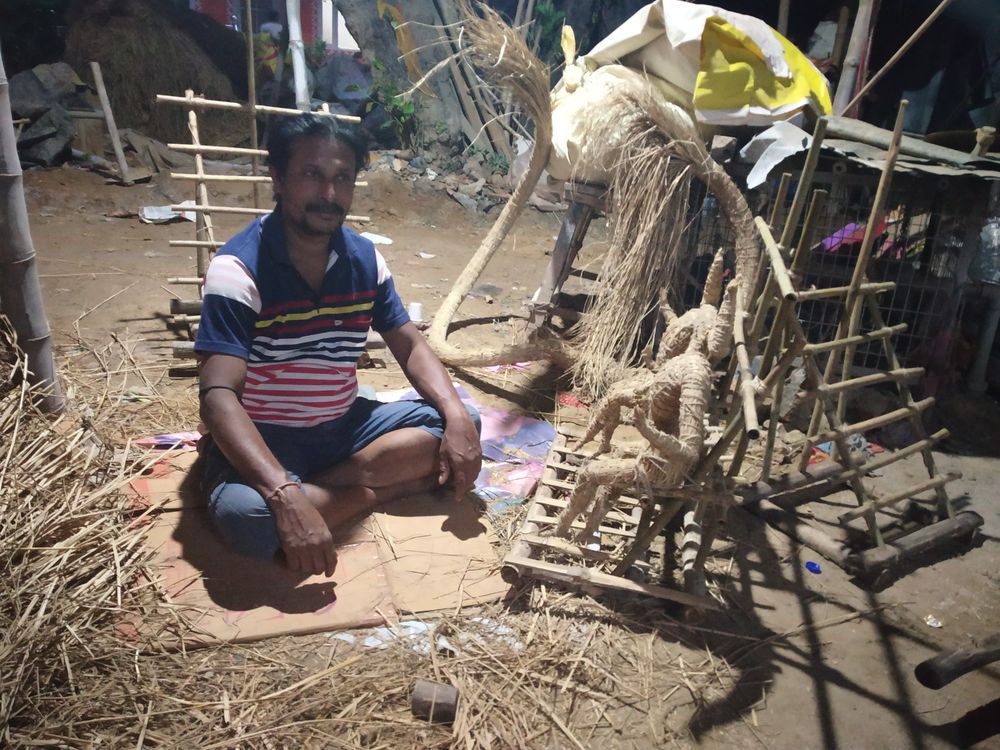At Chittaranjan Park’s Kali Mandir in South Delhi – the hub of Bengali community in the national capital – a group of eleven artisans are sitting on a worn-out bedding inside a shabby tent built out of cloth and iron-poles.
The artisans are rejoicing as their three-month-long hard work is finally on display: a huge idol of goddess Durga.
Every year, a handful of artisans come to Delhi, from Kolkata, at least three months before Durga puja to make these clay figurines. Durga Puja is one of India’s most popular Hindu festivals which is celebrated with great enthusiasm. The devotees worship the idol for five days and later immerse her in the river Yamuna.
But amid celebrations, the artisans behind these life-sized Durga idols are often treated as regular labourers.
Housed in a tent, forty-eight-year old Govind Nath, who came here form Kolkata with his group comprising ten other artisans, says that the tent provides him shelter and a place to work and sleep. “I live here with my wife and kids, including other artists. We sleep, cook and work here; all at the same place,” says Govind, while others start turning to work in order to give a final touch to some of the freshly made idols.

Artisan from Kolkata making the Durga idol. Image credit: Sheikh Saqib.
Govind and his men have experience of over thirty years. They migrated to Delhi three months before Durga puja. “We came here three months back. Since then we are working night and day. Initially, we would start our work at around 8 in the morning till two in the evening. Then we would rest till six and from then work till 1 in the night. But as the puja came closer, we would hardly sleep,” said 38-year-old Narayan Bhatachariya, another artist who works under Govind.
Bhatachariya earns Rs 15,000 per month, which, he says, is sufficient to sustain but still less to fulfil the family’s desires. “I am proud that I do something which makes people happy. The smile on their faces when they see the newly built idols gives me immense pleasure and satisfaction. But you can’t eat satisfaction. You have to earn enough to satisfy your family which is very hard in this profession,” Bhatachariya said.
Also read: Inside the Bleak World of Delhi’s Contractual Labourers
Bhattachariya has started working on a new contract of making idols which his boss and co-worker, Govind, got a few days ago. He says that the government should look into the state of artists like him.
“The kids of this generation are not ready to do this kind of job because there is more hard work and less money. We can only expect a shift in the coming times, only if the government starts investing in us,” he said adding, “If the Chittaranjan Park committee had not built this shed-like structure for accommodation, we could have been living in a much worst condition.”
The other co-workers said that a lot of people came to visit them and distributed sweets to applaud their hard work.
“Many people came and shared sweets with us just to compliment us. Most of them were young people, in their early twenties, and were shocked to see us living in a shed. They probably thought that we’d be enjoying our time in some concrete air-conditioned building,” one co-worker said.
The young people, artisans say, sat with them and praised their work.
“I could sense their empathy towards us which felt good because there is hardly anyone who cares,” another artist said.
As Bhatachariya and his co-workers settle on the dust-ridden floor to work on the new idols, Bhatachariya talks about the hard work that goes behind making Durga Idols.
“As the tradition goes, the priest of the Durga Puja has to get soil from a prostitute’s house. Some claim that the soil is considered to be the purest as men while visiting them leave their purity and virtue at her place. This symbolises the importance of woman power,” while adding: “When all these formalities are done, we then build the figurines out of straw, chaff, and clay and place them in the sun to dry.”
However, making idols of such importance, he says, in a dusty shed only to be underpaid is very disappointing.

Durga idols in the making at Chittaranjan Park. Image credit: Sheikh Saqib.
“Sometimes, when I wake up from sleep after work, I feel like my whole body is broken, and I think of changing my profession,” Bhatachariya said while stressing how much he works hard for a small amount of money, “But then, I can only make ideals and that’s the only skill I have.”
According to official figures, artisans are the backbone of the non-farm rural Indian economy, with an estimated seven million artisans and upto 200 million artisans engaged in craft production to earn a livelihood.
According to the UN, over the past 30 years, the number of Indian artists has decreased by 30%. In a research report, Crafting a Livelihood, released by Dasra, a leading philanthropic foundation, 50% of household heads of craft producing families have no education with 90% of the women in these families being completely uneducated. It states that craft is a family activity as 76% of them attribute their professions to tradition and legacy.
The report further states, “Propelled by loss of markets, declining skills and difficulty catering to new markets, a large number of artisans have moved to urban centres in search of a low, unskilled unemployment in the industry. The Indian government, private sector and non-profits are each involved in the sector but their roles have evolved in silos with little
specialisation and much duplication.”
Sheikh Saqib is a journalist and is presently based in New Delhi
Featured image credit: Unsplash

